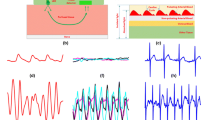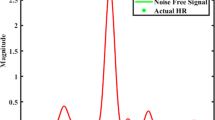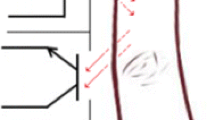Abstract
The use of photoplethysmography (PPG) on the wrist to measure physiological indicators has attracted wide attention because of the portability and real-time characteristic of this technology. However, accurate estimation of the heart rate (HR) is difficult to realize using PPG because of the interference of motion artifacts. To address this problem, a method combining multichannel PPG signals is proposed. By using a peak selection method that combines several factors based on scores, the appropriate frequency is selected from the spectrum of the PPG signals. The chosen frequency is then considered as the HR. The approach exhibits high accuracy and speed. Experimental results for 12 training sets showed that with the proposed method, an average absolute error of 1.16 beats per minute (BPM) (standard deviation: 1.56 BPM) was obtained. Therefore, the proposed approach is reliable for HR monitoring from PPG during high-intensity physical activities. It can be applied to smart wearable devices for fitness tracking and health information tracking.








Similar content being viewed by others
References
Thayer JF, Yamamoto SS, Brosschot JF (2010) The relationship of autonomic imbalance, heart rate variability and cardiovascular disease risk factors. Int J Cardiol 141(2):122–131
Koehle MS, Guenette JA, Warburton DER (2010) Oximetry, heart rate variability, and the diagnosis of mild-to-moderate acute mountain sickness. Eur J Emerg Med 17(2):119–122
Hertzman G (1938) The blood supply of various skin areas as estimated by the photoelectric plethysmograph. Amer J Physiol 124(2):328–340
Sahni R, Gupta A, Ohira-Kist K, Rosen TS (2003) Motion resistant pulse oximetry in neonates. Arch Dis Child Fetal Neonatal Ed 88(6):F505–F508
Kim BS, Yoo SK (2006) Motion artifact reduction in photoplethysmography using independent component analysis. IEEE Trans Biomed Eng 53(3):566–568
Comtois G, Mendelson Y, Ramuka P (2007) A comparative evaluation of adaptive noise cancellation algorithms for minimizing motion artifacts in a forehead-mounted wearable pulse oximeter. In 2007 29th Annual International Conference of the IEEE Engineering in Medicine and Biology Society, pp. 1528–1531.
Barreto AB, Vicente LM, Persad IK (1995) Adaptive cancelation of motion artifact in photoplethysmyographic blood volume pulse measurements for exercise evaluation. In Proceedings of 17th International Conference of the Engineering in Medicine and Biology Society, pp. 983–984.
Ram MR, Madhav KV, Krishna EH, Komalla NR, Reddy KA (2012) A novel approach for motion artifact reduction in PPG signals based on AS-LMS adaptive filter. IEEE Trans Instrum Meas 61(5):1445–1457
Han H, Kim J (2012) Artifacts in wearable photoplethysmographs during daily life motions and their reduction with least mean square based active noise cancellation method. Comput Biol Med 42(4):387–393
Asada HH, Jiang HH, Gibbs P (2004) Active noise cancellation using MEMS accelerometers for motion-tolerant wearable bio-sensors. In The 26th Annual International Conference of the IEEE Engineering in Medicine and Biology Society (IEMBS), pp. 2157–2160.
Sch¨ack T, Sledz C, Muma M, Zoubir AM (2015) A new method for heart rate monitoring during physical exercise using photoplethysmographic signals. In 2015 23rd European Signal Processing Conference (EUSIPCO). IEEE, pp. 2666–2670.
Zhang Z, Pi Z, Liu B (2015) TROIKA: a general framework for heart rate monitoring using wrist-type photoplethysmographic signals during intensive physical exercise. IEEE Trans Biomed Eng 62(2):522–531
Zhang Z (2015) Photoplethysmography-based heart rate monitoring in physical activities via joint sparse spectrum reconstruction. IEEE Trans Biomed Eng 62(8):1902–1910
Fujita Y, Hiromoto M, Sato T (2017) PARHELIA: Particle filter-based heart rate estimation from photoplethysmographic signals during physical exercise. IEEE Transactions on Biomedical Engineering, pp. 1–1.
Nathan V, Jafari R (2017) Particle filtering and sensor fusion for robust heart rate monitoring using wearable sensors. IEEE Journal of Biomedical and Health Informatics, pp. 1–1.
Fallet S, Vesin JM (2015) Adaptive frequency tracking for robust heart rate estimation using wrist-type photoplethysmographic signals during physical exercise. 2015 Computing in Cardiology Conference (CinC) IEEE, pp. 925-928
Fallet S, Vesin JM (2017) Robust heart rate estimation using wrist-type photoplethysmographic signals during physical exercise: an approach based on adaptive filtering. Physiol Meas 38(2):155–170
Liao HE (2005) Two discrete oscillator based adaptive notch filters (OSC ANFs) for noisy sinusoids. IEEE Trans Signal Process 53(2):528–538
Shin J, Cho J (2019) Noise-robust heart rate estimation algorithm from photoplethysmography signal with low computational complexity. Journal of Healthcare Engineering 2019
Zhao D et al (2017) SFST: a robust framework for heart rate monitoring from photoplethysmography signals during physical activities. Biomed Signal Process Control 33:316–324
Longmore SK, et al. (2019) A comparison of reflective photoplethysmography for detection of heart rate blood oxygen saturation and respiration rate at various anatomical locations. Sensors 19(8):1874.
Schack T, et al. (2015) 2015 23rd European signal processing conference (EUSIPCO) - A new method for heart rate monitoring during physical exercise using photoplethysmographic signals. Signal Processing Conference IEEE, 2015:2666–2670.
Sun B, Zhang Z (2015) Photoplethysmography-based heart rate monitoring using asymmetric least squares spectrum subtraction and bayesian decision theory. IEEE Sens J 15(12):7161–7168
Zhang Y, Liu B, Zhang Z (2015) Combining ensemble empirical modedecomposition with spectrum subtraction technique for heart ratemonitoring using wrist-type photoplethysmography. Biomed Signal Process Control 21:119–125
Islam MT, Tanvir AS (2018) Cascade and parallel combination (CPC) of adaptive filters for estimating heart rate during intensive physical exercise from photoplethysmographic signal. Healthcare Technol Lett 5(1):18
Bland JM, Altman DG (1995) Comparing methods of measurement: why plotting difference against standard method is misleading. Lancet 346(8982):1085–1087
Author information
Authors and Affiliations
Corresponding author
Ethics declarations
This article does not contain any studies with human participants or animals performed by any of the authors. The dataset was provided by Zhang et al. in [12] for the Signal Processing Cup 2015.
Additional information
Publisher's Note
Springer Nature remains neutral with regard to jurisdictional claims in published maps and institutional affiliations.
Rights and permissions
About this article
Cite this article
Chen, G., Yuan, X., Zhang, Y. et al. A new approach to HR monitoring using photoplethysmographic signals during intensive physical exercise. Phys Eng Sci Med 44, 535–543 (2021). https://doi.org/10.1007/s13246-021-01003-4
Received:
Accepted:
Published:
Issue Date:
DOI: https://doi.org/10.1007/s13246-021-01003-4




